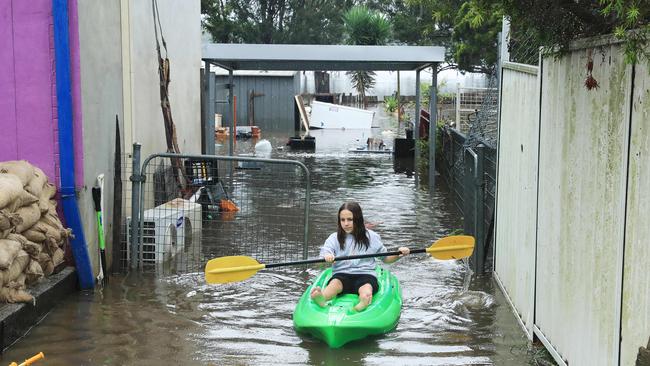Federal government, insurers: stop housing in flood-risk zones
The Morrison government and major insurers are demanding an end to uncontrolled development on the floodplains of the Hawkesbury-Nepean Valley.

The Morrison government and major insurers are demanding an end to uncontrolled development on the floodplains of the Hawkesbury-Nepean Valley, as the Berejiklian government said it would pause plans to move more than 130,000 new residents into areas now declared disaster zones.
The flood crisis has highlighted the need for a “tough conversation” about building on the floodplain, according to federal Emergency Management Minister David Littleproud, who criticised the NSW government over its previous inaction.
“State government has that authority over local government, and we’d expect the state governments to get tighter on this, to understand the risks of natural disaster to those planning decisions they make,” Mr Littleproud told ABC radio on Monday.
“The Australian taxpayer can’t keep coming back and owning this. We can’t be the insurer of last resort, the Australian taxpayer only has finite resources. And this is where the states can show some leadership.”
But NSW Planning Minister Rob Stokes said on Monday he had paused approval of future residential rezonings northwest of Sydney until Infrastructure NSW had completed a business case to support the Hawkesbury-Nepean Valley Flood Strategy.
“For some time we have had a planning policy that dictates any new development should be above the 1 in 100 chance per year flood mark,” Mr Stokes said.
“Tragically, many of the houses affected by the current flooding event have been in places that were developed before that standard was introduced.”
Around 70,000 residents live on flood-affected land in the Hawkesbury-Nepean Valley with plans to move another 130,000 in over the next 30 years. The area contains 25,000 houses, with at least 5000 built below the one -in-a-hundred flood return interval.
Almost 2 million square metres of commercial space is also subject to flood risk, according to WaterNSW.
“Expanding urban development across the valley means that flood exposure will increase in the future. Up to 134,000 people live and work on the floodplain and could require evacuation. This number is forecast to double over the next 30 years,” a WaterNSW report says.

Flood control specialists warn it is not just buildings but critical infrastructure at risk in major flooding, including roads and telecommunications vital in evacuations and rescue operations.
Water scientist Ian Wright, from Western Sydney University, told The Australian his biggest concern was that many people living downstream of Warragamba Dam had no experience of flooding and didn’t realise how quickly the often single-lane roads could become choked.
“We have undersized roads and oversized suburbs in the flood-prone areas and that has to be the priority for all levels of government,” he said.
Insurers describe the flood risk on the Hawkesbury-Nepean flood plain as the most significant and unmitigated community flood exposure in the country
The industry is frustrated by decades of government inaction, with fears insurance claims from the floods could eclipse last year’s $2bn bushfire payouts.
Insurers’ shares were hit as soon as the market opened on Monday, with Suncorp down 2 per cent, IAG falling 2.2 per cent and QBE dropping 3 per cent by close of trade.
Insurance Council Australia chief executive Andrew Hall said: “This has been an ongoing problem, easily predicted and anticipated. We’ve always known western Sydney, the north coast and Townsville are particularly affected by these kind of disasters.
“The critical thing here is that we’ve had 50 to 100 years of data on this and it must be used to inform decisions about construction or at least better building resilience in these regions.”
The NSW government wants to raise the Warragamba Dam wall by around 14 metres, at an estimated cost of $1.6bn, to help mitigate flooding in the Hawkesbury-Nepean Valley.
But that would provide only an extra 991 gigalitres of “airspace”, which would have been overwhelmed by the 1500 gigalitres that flowed into the dam this week alone.
Premier Gladys Berejiklian acknowledged on Sunday it would have made little difference.
Moreover, half the floodwaters in the Hawkesbury-Nepean river system are from other tributaries, not the Warragamba Dam.
Flood specialist Jamie Pittock, from the Australian National University, says raising the wall of Warragamba Dam would not prevent future flood issues and instead put more people in danger.
“That is a really foolish idea,” Professor Pittock told The Australian.




To join the conversation, please log in. Don't have an account? Register
Join the conversation, you are commenting as Logout